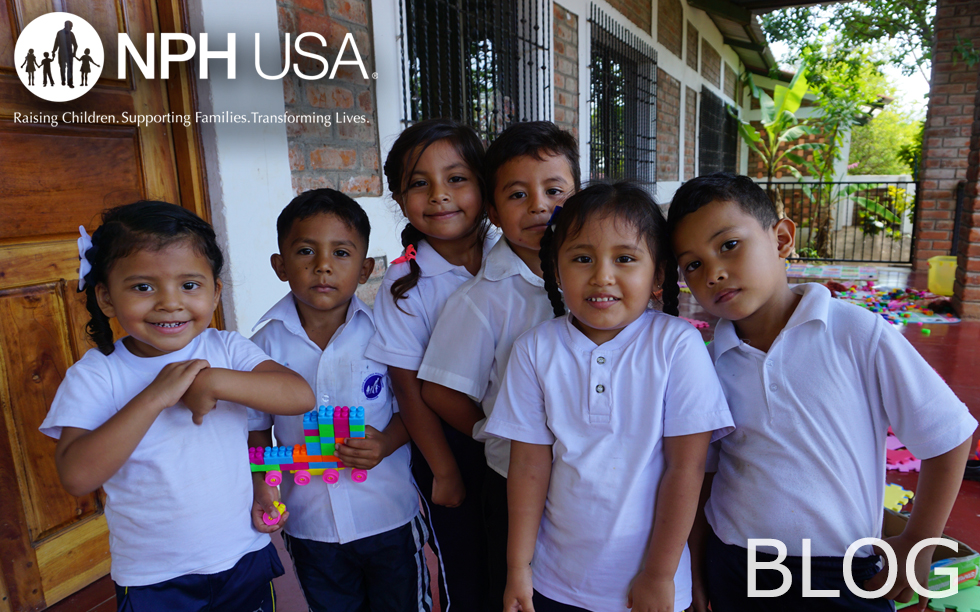Below is a reflection from our partner school Eastside Catholic in Seattle written by Anna Ricci and Karen Skoog who are the teachers who led a recent trip to NPH Nicaragua. They are a longtime and steadfast partner!
In June we had the opportunity to travel to NPH Nicaragua with 9 students and 3 staff members from Eastside Catholic School. As we arrived in Nicaragua we were immediately welcomed into the NPH Nicaragua family. We leaned into the discomfort of a different climate, language barriers, and new faces and quickly realized this was a place we could come as we are and be accepted unconditionally.
One student, Kyleigh, shared the following in a reflection at our opening Mass of the school year. “The first day that we arrived, we put all of our stuff in our rooms at the guest house and went up to the multipurpose area where we were met with over 250 little kids, ranging in age from 5-18, all yelling in Spanish and fighting for the first hug or hand to hold. Despite the language barrier, over the next few days we would get to know these kids and the people at NPH Nicaragua very well, and we were able to develop relationships with them that will last forever. Over the 8 days that we spent there, we were able to go to mass, tour the city, including the Old and New Market, watch the boys NPH soccer team play against the neighboring town, eat meals with the kids, learn to dance, and more. I had so many great experiences and made so many amazing memories on my trip to NPH Nicaragua that I will never be able to forget.”
At a school assembly on Global Citizenship, George reflected on his experience sharing, “With all the disasters and chaos in the world, we know there will always be a need to build roads and schools and hospitals. That is valuable, but our experience was so different. You see the trip really began last fall when NPH flew to visit us. They flew their dance team up to the US and they performed in this very gym; they went to class with us at our school; they ate lunch with us. So really, we were just doing the same thing. We went down and we ate meals with them; we went to class with them, we played with them and did chores around the home to help out. In Nicaragua we built the same thing they built when they came up here. We built the most important thing we can build in our lives. We built something that can stand the test of time, something that can last forever. We built relationships.”
We are so grateful for all the ways these relationships have impacted us and our community at Eastside Catholic.
“One life touches another and potentially both lives are changed; once life touches another and potentially the entire world is changed.” -The Amazing Law of Influence
In June we had the opportunity to travel to NPH Nicaragua with 9 students and 3 staff members from Eastside Catholic School. As we arrived in Nicaragua we were immediately welcomed into the NPH Nicaragua family. We leaned into the discomfort of a different climate, language barriers, and new faces and quickly realized this was a place we could come as we are and be accepted unconditionally.
One student, Kyleigh, shared the following in a reflection at our opening Mass of the school year. “The first day that we arrived, we put all of our stuff in our rooms at the guest house and went up to the multipurpose area where we were met with over 250 little kids, ranging in age from 5-18, all yelling in Spanish and fighting for the first hug or hand to hold. Despite the language barrier, over the next few days we would get to know these kids and the people at NPH Nicaragua very well, and we were able to develop relationships with them that will last forever. Over the 8 days that we spent there, we were able to go to mass, tour the city, including the Old and New Market, watch the boys NPH soccer team play against the neighboring town, eat meals with the kids, learn to dance, and more. I had so many great experiences and made so many amazing memories on my trip to NPH Nicaragua that I will never be able to forget.”
At a school assembly on Global Citizenship, George reflected on his experience sharing, “With all the disasters and chaos in the world, we know there will always be a need to build roads and schools and hospitals. That is valuable, but our experience was so different. You see the trip really began last fall when NPH flew to visit us. They flew their dance team up to the US and they performed in this very gym; they went to class with us at our school; they ate lunch with us. So really, we were just doing the same thing. We went down and we ate meals with them; we went to class with them, we played with them and did chores around the home to help out. In Nicaragua we built the same thing they built when they came up here. We built the most important thing we can build in our lives. We built something that can stand the test of time, something that can last forever. We built relationships.”
We are so grateful for all the ways these relationships have impacted us and our community at Eastside Catholic.
“One life touches another and potentially both lives are changed; once life touches another and potentially the entire world is changed.” -The Amazing Law of Influence



